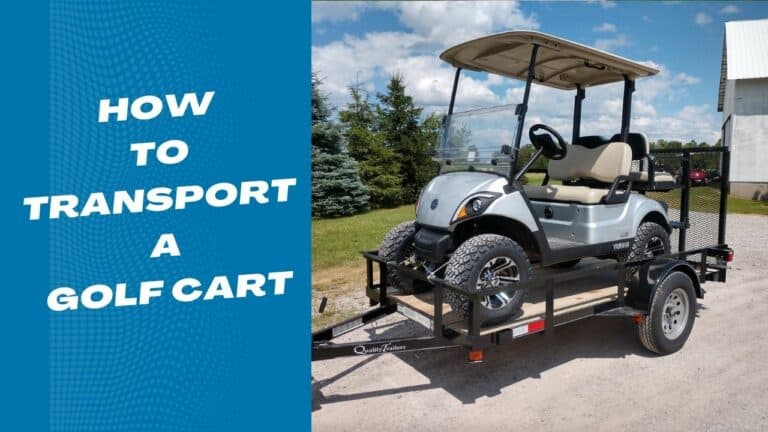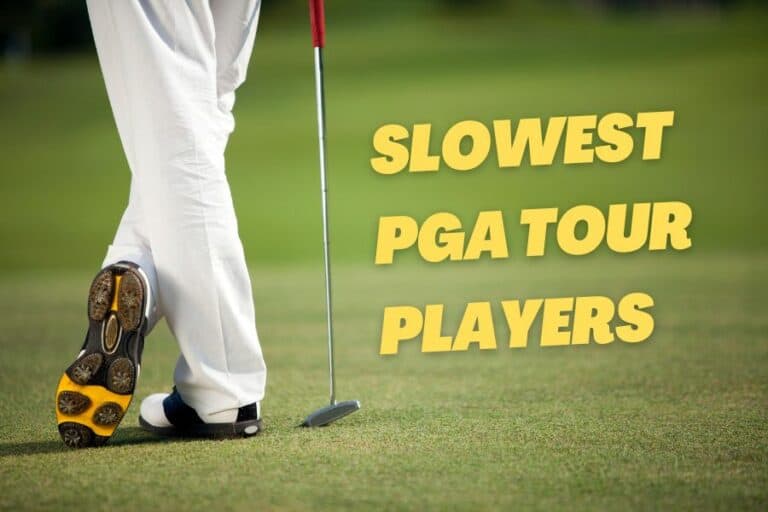Golf Slice Vs. Hook – Differences, Causes, And Ways To Fix

Hook and slice are the most common undesirable golf shots golfers tend to encounter on a golf course. This article helps you understand everything about golf slice vs hook.
Although every golfer aims to hit a straight shot, hitting shots like hook and slice is common. Therefore, it is mandatory to understand and work on these two mishits to get better on the golf course.
This guide has detailed information on a golf slice and hook, the causes, and ways to fix them to improve your game.
I. Golf Slice vs Hook: Golf Shot Shapes
Golfers who struggle with wayward shots know the frustration of hitting a slice or a hook. Both shots can take the ball far off course, adding unnecessary strokes to your scorecard.
A hook is a shot that spins hard to the left, while a slice is a shot that spins hard to the right. If you’re a left-handed golfer, these terms are reversed.
While hooks and slices differ in their spin direction, both shots stem from the same issue: poor face control.
Hook vs. Slice: What’s the Difference?
Here are the basic differences between a hook and a slice in golf:
- A hook is when the ball curves hard to the left for a right-handed golfer (or hard to the right for a left-handed golfer).
- A slice is when the ball curves hard to the right for a right-handed golfer (or hard to the left for a left-handed golfer).
- Both shots are caused by poor face control, meaning the orientation of the clubface at impact is not correct.
- The key difference between a hook and a slice is the direction of the curvature.
II. What is a hook?
A hook is a golf shot where the ball curves dramatically to the left (for a right-handed golfer) due to poor club face control. It is an unwanted shot shape as it is difficult to control and can result in the ball landing in unfavorable positions on the course. The hook is classified into a pull, hook and pull hook.
III. What causes a hook?
- Club face: If the club face is closed at impact, it will cause the ball to hook to the left for a right-handed golfer.
- Grip: A strong grip, which means the hands are rotated too far to the right on the club handle, can cause the clubface to close and result in a hook.
- Swing path: An inside-out swing path can cause the ball to hook. This means the clubhead travels from inside the target line to outside through impact.
- Ball position: If the ball is positioned too far forward in the stance, it can cause the clubface to close and lead to a hook.
- Body position: An improper body position at address, such as standing too close to the ball or having a closed stance, can cause the club to swing too far to the right through impact, resulting in a hook.
| Causes | Hook |
| Club face | Closed clubface |
| Grip | Too tight grip |
| Swing path | In-to-out swing path |
| Ball position | Backward ball position |
| Body position | Too open shoulder |
IV. How to fix a hook?
Here are the some of the ways that can help you fix a hook:
- Strengthen your grip: By moving your hands more to the right on the grip, it can help keep the clubface from closing too much.
- Focus on swing path: Try to swing more from the outside to the inside to help straighten out the ball flight.
- Use less body rotation: Try to focus on keeping your body quieter through impact to avoid closing the clubface too much.
V. What Is A Slice In Golf?
If you are a right-handed golfer, a slice occurs when the ball curves toward the right side of the golf course, and for a left-handed golfer, the golf ball curves toward the left.
Depending upon the golf ball’s direction, slice shots are classified into push, slice, and push slice shots.
VI. What causes a slice?
- Club face: The club face plays a crucial role in causing slices. An open club face at impact results in a slice, while a closed club face helps to correct it.
- Grip: The golf grip is another important factor that influences shots. A weak grip often results in a slice, while a tight grip can cause a hook.
- Swing path: Swing path also affects the direction of the shot. An out-to-in swing path leads to slices, while an in-to-out path can help to reduce it.
- Ball position: The position of the golf ball in the stance is essential for proper alignment. A ball placed too far forward results in slices because it reduces the golf club’s loft. Conversely, golfers who place the ball too far back tend to hit hooks.
- Body posture: Maintaining proper body posture throughout the swing is critical. An open shoulder line can cause a slice, while a closed shoulder line can reduce it.
| Causes | Slice |
| Club face | Open clubface |
| Grip | Too weak grip |
| Swing path | Out-to-in swing path |
| Ball position | Forward ball position |
| Body position | Too closed shoulder |
VII. Swing changes to fix a slice or a hook
Here are some tips to correct a slice or a hook during your golf swing:
1. Adjustment of the upper body
Whether you’re dealing with a hook or a slice, the key to fixing upper body errors is the same. It is important to tilt slightly away from the target. However, be cautious not to tilt too much, as excessive tilt can lead to a hook.
When you’re getting ready for your shot, stand in your regular golf position. Put the golf club against your chest, making sure it’s straight up and down, with the handle in line with your zipper or buttons.
Now, tilt your body a bit away from where you want the ball to go. Keep tilting until the club head touches your lead knee or thigh. That’s how you know you’ve tilted just enough. This easy move can help you hit the ball more accurately in your golf game.
2. Know the right wrist movement
To tackle improper wrist movements, the key is to focus on the logo on your glove. Make sure to pay close attention to the logo on your glove.
However, it’s important to note that the instructions provided presume if you are using a neutral golf grip. If your grip is either strong or weak, you may need to make additional adjustments to accommodate how your grip impacts the position of the club face.
3. Steps to achieve right wrist movement
- Observe your wrists during the takeaway.
- Ensure your hands move slightly inward, with the logo rotating towards the golf ball.
- Avoid excessive twisting toward the ground to prevent a hook.
- At the top of your backswing, find a middle ground for the logo, aiming toward where a caddie would stand.
- Slicers should rotate the logo more toward the sky, while those who hook should rotate it more downward.
VIII. Can Your Clubs Influence Slice and Hook?
Your choice of clubs can indeed influence the tendency for a slice or hook in your golf shots. Using the wrong clubs can make you hit slices or hooks, but choosing the right ones can level up your game.
For instance, using a club with a closed face can help counteract a slice, while an open-faced club may increase it. Experimenting with different clubs allows golfers to find the right club according to their preferences.
The key factor is the club face angle. A closed face, pointing left of your target, can lead to a hook, making the ball curve left. On the other hand, an open face, pointing right at your target, may cause a slice, making the ball curve right. Choosing the right clubs, taking face angles into account, can help prevent these undesired curves and enhance your shots.
IX. The Hook Vs Slice – Which Is Worse?
Hooks and slices are two of the worst shots in golf when you don’t intend to curve your ball. Both shots can negatively affect distance and accuracy, and require an extra stroke or more to recover lost ground.
- Hooks and slices are mirror versions of each other, but have key differences in ball flight.
- Hooks have a lower trajectory and will roll more on landing.
- Slices have a higher flight path and typically cover less distance.
- Both shots are challenging to control and unpredictable.
In a quick glimpse: Slice or Hook, Which is Worse?
- Whether hooks or slices are worse depends on the situation on the golf course.
- In the short game, hooks are less favorable because low trajectories are dangerous for attacking fast greens where stopping the ball quickly upon landing is the goal.
- In contrast, hooks can be a better option for longer shots when power and distance are the priority because they can gain more ground than slices.
X. Why do I slice driver but not irons?
Slicing the driver but not irons is common among golfers. It’s due to differences in club characteristics and swing mechanics.
The driver has a longer shaft, a larger clubhead, and less loft than irons, making it more difficult to control the clubface and swing path.
Additionally, differences in swing plane could also be a contributing factor. To address this issue, golfers can work on improving their swing mechanics and making adjustments to their setup to promote a more neutral clubface position at impact.
XI. Best Training Aids for Hooks and Slices
Best Training Aids for Hooks and Slices:
1.Lag shot golf club – helps to develop a late release in the swing, which can help to eliminate hooks and slices.
2. Plantmate swing trainer – uses a resistance band to help train the proper swing path, which can correct slices and hooks.
3. Eyeline speed trap – a training aid that helps to improve swing path and clubface alignment, which can help to eliminate hooks and slices.
Conclusion
Identifying the golf shot you are hitting and understanding the causes contributing to the golf slice and hook is the best way to improve your game.
You can fix golf slices and hooks with practice and a good golf swing technique and master the golf game.
FAQ’s
1. Is It Better To Hook Or Slice?
Eliminating both hooks and slices is crucial for consistent good golf scores. While both swing flaws need practice, a hook is easier to correct with slight tweaks compared to a slice, which often requires major swing adjustments.
Interestingly, new golfers struggle with a slice while seasoned golfers fight a hook.
2. Why Does A Hook Go Further Than A Slice?
A hook goes even further when compared to other shots. When you hit a hook, you typically use a closed and delofted clubface. This results in less spin on the ball and higher compression, meaning that it will fly further than if you had used a slice.
3. Do Anti Slice Golf Tees Work?
Though anti-slice tees don’t completely eliminate the slice shape from your game, they do help to decrease side spin and give you a better opportunity of succeeding on your following shot. While you will still experience slices with this tee, their effects can be lessened significantly.
4. How Is A Golf Hook Vs Slice Different For Left Handers?
A hook is a type of shot that curves from right to left for a right-handed golfer, but for a left-handed golfer, the hook curves from left to right. The opposite is true for a slice, which curves from left to right for a right-handed golfer and from right to left for a left-handed golfer.








